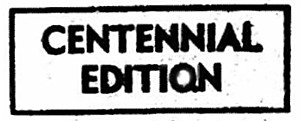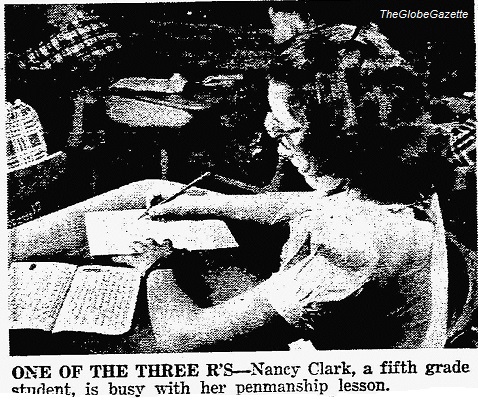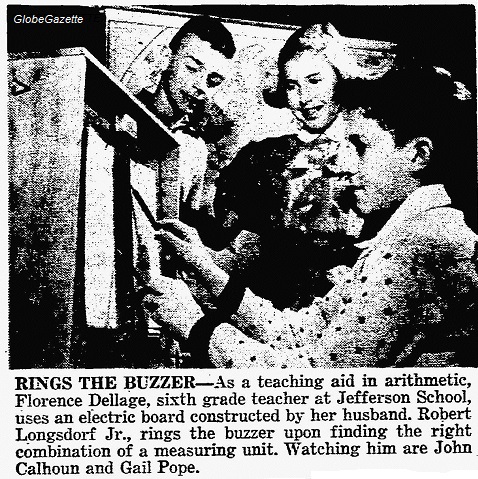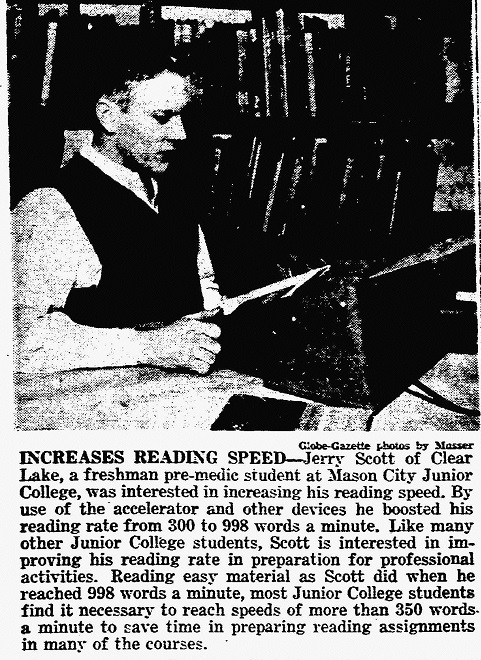


Cerro Gordo County Iowa
Part of the IaGenWeb Project
|
The Globe Gazette


THE STORY of THE SCHOOLS
First Mason City Teacher Held Classes in Log Cabin
She was the mother of Mrs. C. D. Dobson, 1142 Maple Drive, and grandmother of Mrs. Verdelle Hansen, Mrs. Cecil McVicker and Mrs. Shirley Reynolds of Mason City. Mrs. Thompson and her husband Albert (sic, Adelbert according his gravestone inscription), had a hotel and also operated a drug store on the present [1953] site of Aldens. It was the parents of the pupils in the earliest days who determined to the best of their ability the qualifications of the teachers and contracted for their services and wages as well as seeing that the schools were taught and managed in an efficient manner. Wages paid teachers sometimes were as low as $2.50 a week. The teacher paid a dollar a week for board.
NOTE: A. M. [Adelbert Mason] Thompson, the son of Benjamin Jr. and Lucena (Gibbs) Thompson, was born in 1834, Gilsum, New Hampshire. He was elected Cerro Gordo County Sheiff in October of 1867. He married, in New Hampshire, Elizabeth "Lizzie" Boyton who in 1856 taught at the Long School, Mason City's first school. A. M. died December 7, 1899, Mason City. Lizzie was born in Cheshire County, New Hampshire on October 6, 1836, and died in Mason City on June 12, 1884. They were interred at Elmwood Cemetery, Mason City, Iowa. The class of 1878 was the first to be graduated from Mason City High School. There were seven members in the class. They were R. W. Montague, Ellen A. Barton Montague, R. J. Miller, Minnie Egloff Long, Ella M. Mayne Lucas, Alpha Valentine and Lucy Barton Valentine.
In 1881 only two Mason City School diplomas were granted. The graduates, both of whom lived outside of Mason City, were Abbie Parker, who lived north of the present [1953] site of the American Beet Sugar Company plant, and Harriet True, who lived on a farm north of the city. There is no longer any considerable demand for "copper plate" perfection* in writing. But it is more necessary today than ever before that each individual be able to write legibly, easily, and neatly. The use of handwriting in business and social life has multiplied many times over within the last generation. Writing has ceased to become the profession of the few and has become the tool of the many. Its function is to record and communicate thought and thus it serves to increase the efficiency and happiness of each individual in the varied relationships of life. The most significant change in the concept of teaching handwriting is the shift from perfection to usefulness, from abstract drill to concrete function. This point of view calls for change of emphasis from the accuracey of form, exact slant, size of letters, height, etc., to the more important factor of neatness and legibility. The standard evaluation should be: Any writing is good writing which is easily written and easily read. Neatness of arrangement is a strong incentive to more legible writing. A second important change in the concept of teaching writing is that the mechanics of writing must be correlated with the process of thinking. Interest in the mechanics of writing follows interest in its use. Courses are offered throughout the Mason City Public School system to provide opportunities for the application of this philosophy.


* "Copper plate perfection" - also known as "English round hand" or "Script" - is a calligraphic style of writing that utilizes a sharp
pointed nib instead of the normally used flat nib in calligraphic writing. The name was derived from the fact that students learned this style of
calligraphy from copybooks that were printed from etched copper plates. Copper plate script, prevalent during the 19th century for the most part,
is used to refer to any old-fashioned, tidy, graceful style of handwriting. In this style of calligraphy, the thickness of the stroke is determined by
the amount of pressure applied when writing and all forms (letters, numbers and punctuation) are written at a slant of 55 degrees from the horizontal.



Photographs courtesy of Globe-Gazette unless otherwise noted Some of the photographs did not scan well. In such a case the photograph has been substituted with a clearer copy if available. Transcriptions and Note by Sharon R. Becker, August of 2015 Information obtained in notes from other Globe-Gazette articles
|
Return to Centennial School Index Page Return to Mason City Centennial Index Page Return to History Index Page Return to Cerro Gordo Home Page